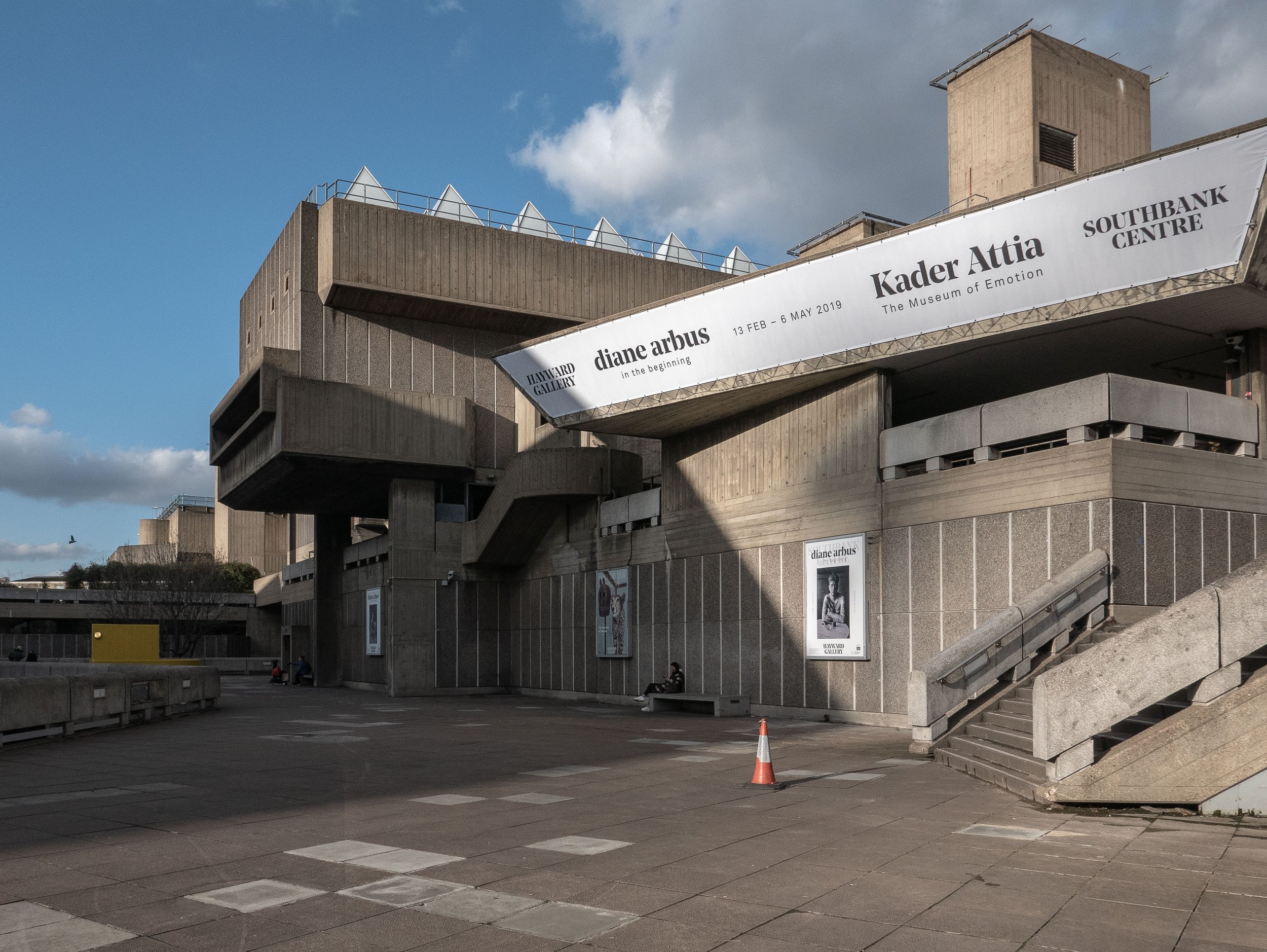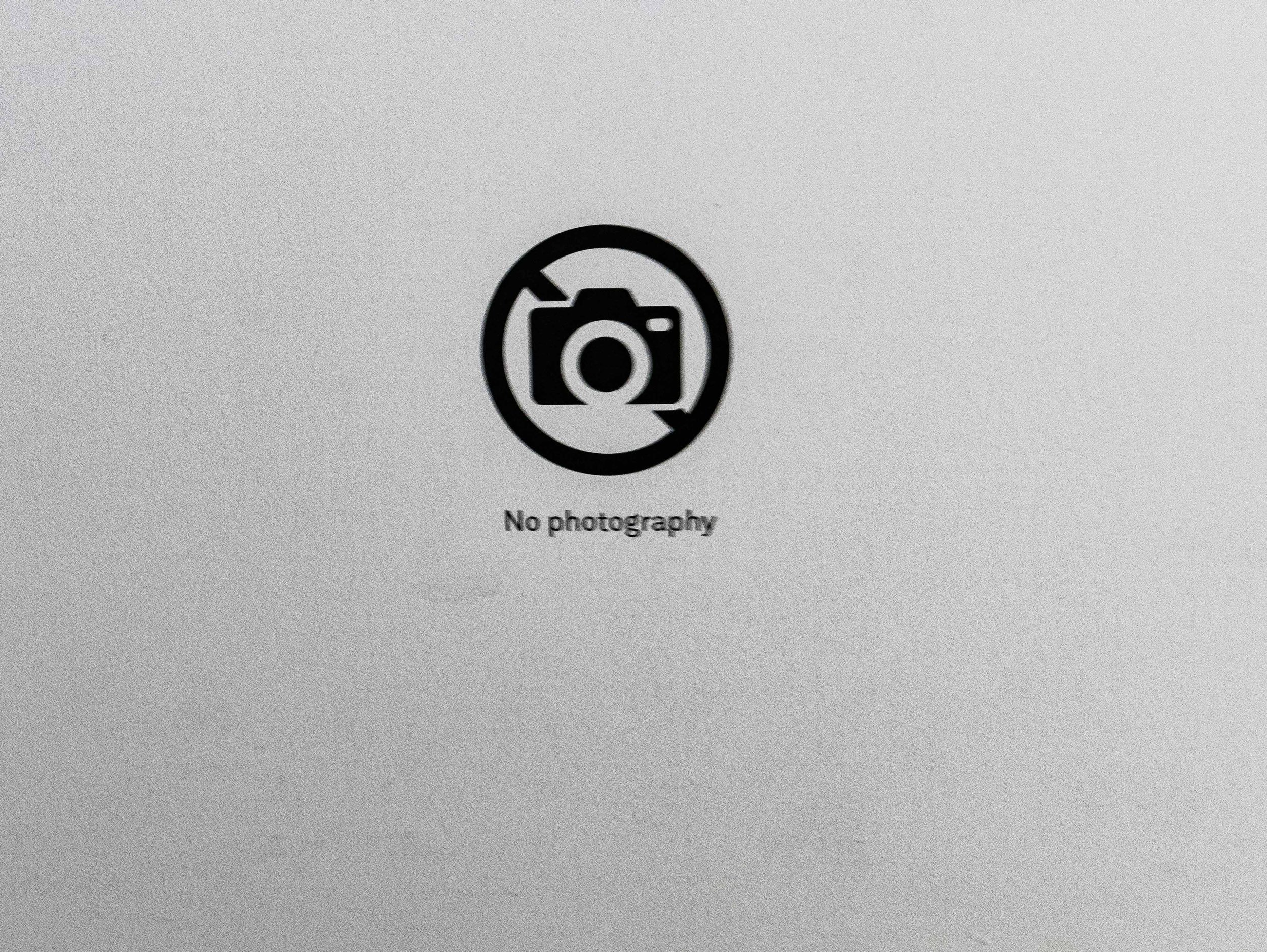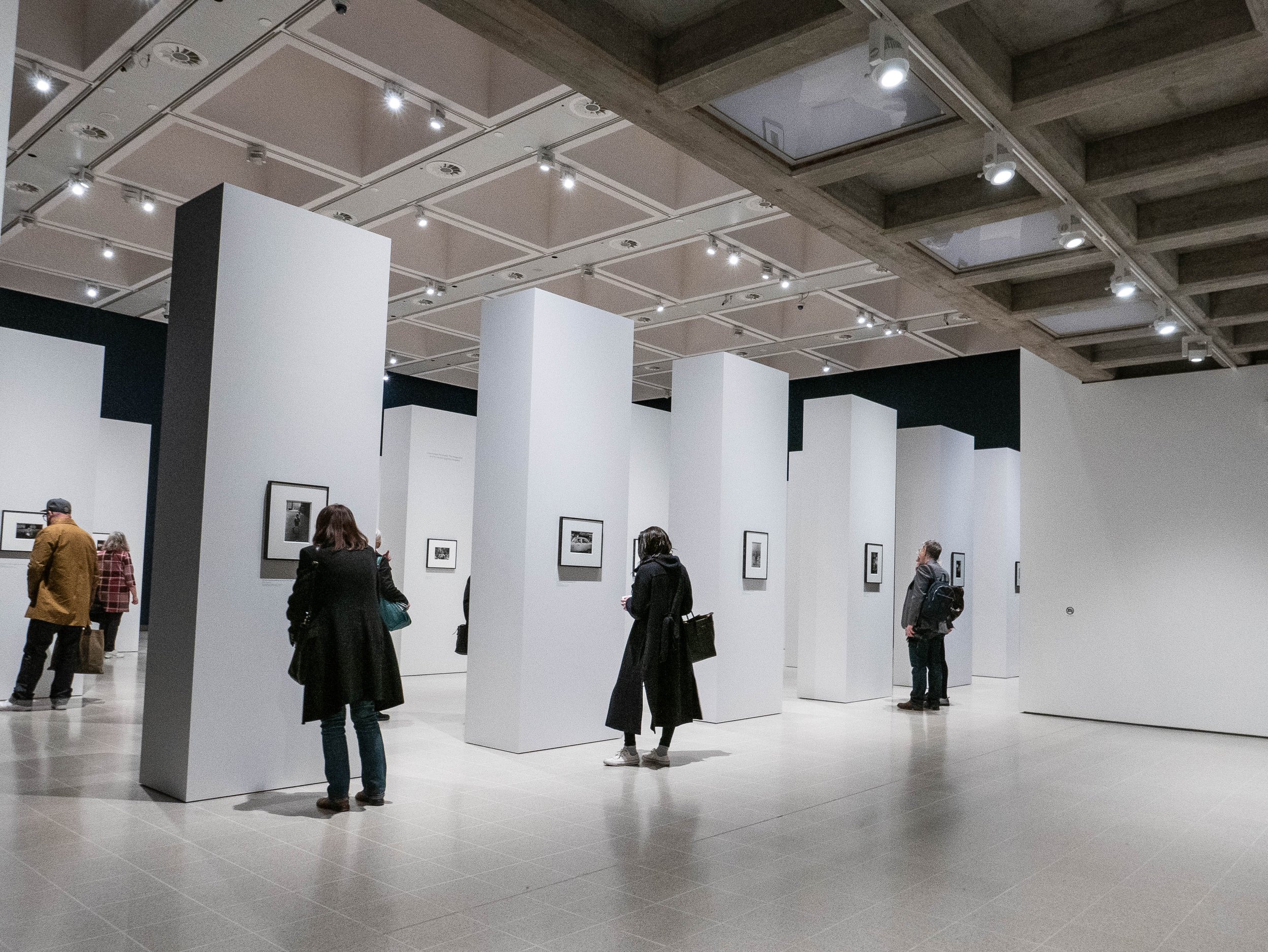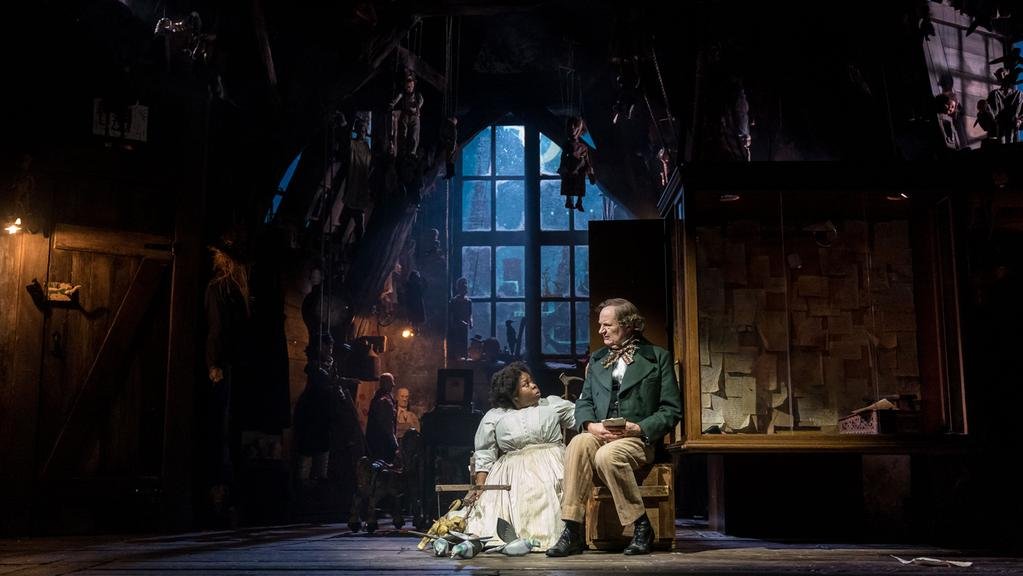 The Hayward gallery in the South Bank Centre in London is currently showing an exhibition of original monochrome analogue photographs made by Diane Arbus (1923-1971) between 1956 and 1962. Although from the age of eighteen, she had worked in fashion and advertising alongside her husband, the actor and photographer Allan Arbus, she did not embark on the work for which she is now well known, until she was in her early thirties. At that time, while she was studying with Lisette Model, she began to make photographs of people she met in the street in and around the less affluent areas of New York City and Coney Island. These images, best described as her early formative work, were made using 35mm film cameras printed at 6 x 9 inches by Arbus herself and two thirds of them have not been shown previously in the U.K.
The Hayward gallery in the South Bank Centre in London is currently showing an exhibition of original monochrome analogue photographs made by Diane Arbus (1923-1971) between 1956 and 1962. Although from the age of eighteen, she had worked in fashion and advertising alongside her husband, the actor and photographer Allan Arbus, she did not embark on the work for which she is now well known, until she was in her early thirties. At that time, while she was studying with Lisette Model, she began to make photographs of people she met in the street in and around the less affluent areas of New York City and Coney Island. These images, best described as her early formative work, were made using 35mm film cameras printed at 6 x 9 inches by Arbus herself and two thirds of them have not been shown previously in the U.K. As perhaps expected, the quality of the images does not equate with that of her much better known later medium format photographs but the gallery did not permit photography in this exhibition so I have no available examples to show. There was a small area, separate from the main body of the exhibition, showing a folio of ten of her medium format prints (printed at 20 x 20 inches) and the difference in quality was clearly evident. That said, the earlier photographs explored a wider range of subject matter, informal portraits, street photography, people in fairgrounds or at the beach, cinema and theatre audiences and people through restaurant windows. A few images appeared to be screen shots on television sets and there were some found still lives on wet pavements. Several of the prints showed pronounced grain effects and in some (especially the low-light images) the focus was quite soft but this imparted a degree of freshness or rawness to the work which appeared less planned or staged than her photographs from the mid 1960's onwards. This would be an important collection for anyone studying Diane Arbus, demonstrating the early stages of the evolution of her working practice.
As perhaps expected, the quality of the images does not equate with that of her much better known later medium format photographs but the gallery did not permit photography in this exhibition so I have no available examples to show. There was a small area, separate from the main body of the exhibition, showing a folio of ten of her medium format prints (printed at 20 x 20 inches) and the difference in quality was clearly evident. That said, the earlier photographs explored a wider range of subject matter, informal portraits, street photography, people in fairgrounds or at the beach, cinema and theatre audiences and people through restaurant windows. A few images appeared to be screen shots on television sets and there were some found still lives on wet pavements. Several of the prints showed pronounced grain effects and in some (especially the low-light images) the focus was quite soft but this imparted a degree of freshness or rawness to the work which appeared less planned or staged than her photographs from the mid 1960's onwards. This would be an important collection for anyone studying Diane Arbus, demonstrating the early stages of the evolution of her working practice. For my own research, perhaps the most striking aspect of this exhibition was the way in which the work was presented (I made the one photograph shown above before I noticed the small 'No Photography' sign on the plain wall on the right of the image). There were no photographs on the perimeter walls of the space, which were painted in a deep rich matt navy blue (almost black) colour. As shown, the main gallery contained about forty evenly spaced free standing pillars painted in matt white with one photograph only on each long side. The prints were traditionally window mounted in dark metallic pewter like frames and the immediate impressions created by the design were of light airiness and opulently high quality minimalist precision, with a hushed atmosphere indicating genuine reverence for the work being presented.Diane Arbus tragically took her own life in 1971 and I think she would have been pleased with this exhibition but although the gallery has gone to great lengths (and expense) to create an impressive setting for the photographs, I felt to an extent that the design almost overwhelmed the actual images, perhaps reinforcing my impression that this was not her best work. In the information at the gallery entrance, the curators explained that the work had not been arranged in any chronological order and that viewers should feel free to find their own route around the gallery at their own pace. This worked well while the gallery was initially quiet but it filled up quite quickly and I was conscious of people around me moving from pillar to pillar in different directions at different speeds to the extent that I felt under pressure to move on, to avoid holding them up. Although many were individually fascinating, the disparate selection of images were placed surprisingly randomly with no obvious attempt to formally sequence them. This could of course have been an attempt to subliminally re-create the feel of the circumstances in which they were created but overall it felt more like a triumph of style over substance.https://www.southbankcentre.co.uk/whats-on/exhibitions/hayward-gallery-art/diane-arbus-beginninghttps://www.biography.com/people/diane-arbus-9187461
For my own research, perhaps the most striking aspect of this exhibition was the way in which the work was presented (I made the one photograph shown above before I noticed the small 'No Photography' sign on the plain wall on the right of the image). There were no photographs on the perimeter walls of the space, which were painted in a deep rich matt navy blue (almost black) colour. As shown, the main gallery contained about forty evenly spaced free standing pillars painted in matt white with one photograph only on each long side. The prints were traditionally window mounted in dark metallic pewter like frames and the immediate impressions created by the design were of light airiness and opulently high quality minimalist precision, with a hushed atmosphere indicating genuine reverence for the work being presented.Diane Arbus tragically took her own life in 1971 and I think she would have been pleased with this exhibition but although the gallery has gone to great lengths (and expense) to create an impressive setting for the photographs, I felt to an extent that the design almost overwhelmed the actual images, perhaps reinforcing my impression that this was not her best work. In the information at the gallery entrance, the curators explained that the work had not been arranged in any chronological order and that viewers should feel free to find their own route around the gallery at their own pace. This worked well while the gallery was initially quiet but it filled up quite quickly and I was conscious of people around me moving from pillar to pillar in different directions at different speeds to the extent that I felt under pressure to move on, to avoid holding them up. Although many were individually fascinating, the disparate selection of images were placed surprisingly randomly with no obvious attempt to formally sequence them. This could of course have been an attempt to subliminally re-create the feel of the circumstances in which they were created but overall it felt more like a triumph of style over substance.https://www.southbankcentre.co.uk/whats-on/exhibitions/hayward-gallery-art/diane-arbus-beginninghttps://www.biography.com/people/diane-arbus-9187461
A Very Very Very Dark Matter
My son bought us tickets for this new play at the Bridge Theatre on London’s South Bank, because he knew that I had enjoyed the work of the playwright Martin McDonagh (who wrote the film screenplays for ‘In Bruges’ and ‘Three Billboards Outside Ebbing Missouri’). On that basis but knowing little else about it in advance, we expected a story with dark humour, irreverence, subversion and unpredictable plot twists – and it had all of these, at least in parts. The first and third acts starred Johnetta Eulua’Mae Ackles as a Congolese dwarf imprisoned in a locked cage, suspended from the ceiling of an attic in mid-19th century Copenhagen, in which she was forced to write stories for Hans Christian Andersen (played as a pompous overbearing buffoon by Jim Broadbent), who then published them in his own name and who had also cut off her right foot to stop her escaping. The story was explained by an offstage narrator, voiced by Tom Waits (presumably pre-recorded) and centred on the contradictory and ambiguous aspects of the personality of the prolific and highly successful writer of children’s stories, as well as some less well known novels and travelogues. Other issues explored included disability/deformity, racism, colonialism, genocide (by the Belgian Army in the Congo), authorship/plagiarism, repressed but ambiguous sexuality, obsessive but unrequited passion, time-travelling ghosts and a haunted accordion with a concealed machine gun.While this all sounds like a surrealist fantasy (which is what I think it was), it is evident that the author has undertaken a considerable amount of research in preparation for writing the story. Several biographers have referred to Andersen’s unusual personality, based on contemporary accounts and from his own diaries. He had a difficult childhood in which he was abused by strictly religious adoptive parents. He was celibate because of his religious beliefs and never married but became intensely infatuated at various times in his life with individuals of both sexes, none of whom reciprocated his feelings (Lepage, 2006). The second act, set around Charles Dickens’ dining room table, was based on a visit by Andersen to the author’s home in which he bored and irritated Dickens and his family by outstaying his welcome by several weeks. He died in unusual circumstances after falling out of his bed and a small skeleton with the right foot missing, was found in his attic after his death.Press reviews of the play have been at best mixed, with several commenting that the plot was overcomplicated, disjointed, deliberately shocking to the point of being over-sensationalised and some found the humour gratuitously offensive (Online reviews, 2018). It seemed as if the play had been written in a hurry or possibly originally envisaged as a film and I thought the story did at times stray close to the line between an effective piece of ‘theatre of the absurd’ and flippant or frivolous silliness. For me however this was offset greatly by the dark shadowy lighting and the atmospheric set design of the attic by Anna Fleischle, with Gothic arched ceilings, scattered dolls and children’s toys and hanging puppets. The effect of this was to create a uniquely surreal visual experience and although the script could have been more cohesive, it was a very different and enjoyable theatrical spectacle, a dark stranger than fiction fairytale.ReferencesLepage R, 2006. ‘The perverse side of Hans Christian Andersen’, Guardian newspaper article Accessed on 30/11/2016 at: https://www.theguardian.com/books/2006/jan/18/theatre.classicsOnline reviews, 2018. Accessed on 30/11/2018 at: https://www.whatsonstage.com/london-theatre/news/very-dark-matter-review-round-up-critics-bridge_47880.htmlImagesFeatured banner image copied from the Bridge Theatre website, Accessed on 5/12/2018 at: https://bridgetheatre.co.uk/whats-on/a-very-very-very-dark-matterSet design photograph copied from the Jewish Chronicle website, Accessed on 5/12/2018 at: https://www.thejc.com/culture/theatre/theatre-review-a-very-very-very-dark-matter-1.472020
The effect of this was to create a uniquely surreal visual experience and although the script could have been more cohesive, it was a very different and enjoyable theatrical spectacle, a dark stranger than fiction fairytale.ReferencesLepage R, 2006. ‘The perverse side of Hans Christian Andersen’, Guardian newspaper article Accessed on 30/11/2016 at: https://www.theguardian.com/books/2006/jan/18/theatre.classicsOnline reviews, 2018. Accessed on 30/11/2018 at: https://www.whatsonstage.com/london-theatre/news/very-dark-matter-review-round-up-critics-bridge_47880.htmlImagesFeatured banner image copied from the Bridge Theatre website, Accessed on 5/12/2018 at: https://bridgetheatre.co.uk/whats-on/a-very-very-very-dark-matterSet design photograph copied from the Jewish Chronicle website, Accessed on 5/12/2018 at: https://www.thejc.com/culture/theatre/theatre-review-a-very-very-very-dark-matter-1.472020

